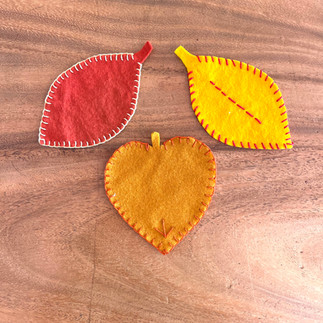Hand Sewing Through the Grades: Building Foundations and Meeting Individual Needs
- Shellie Smith

- Oct 7, 2023
- 3 min read

Last month in our online Handwork Teacher Development program we had a wonderful discussion with our students about spiraling handwork skills throughout grades 1-8 to deepen learning and support student success. Here at WHE, we like to say we are always either building a foundation or building ON a foundation. For the children to develop to their highest capacity, the skills we are teaching in handwork cannot be isolated to one specific age or grade. Knitting, crochet, and sewing, for example, are not islands unto themselves. But rather, part of a bigger picture of deeper learning and child development.
Let’s take a closer look at hand sewing. If we reserve hand stitching for the 4th, 6th, and 7th grades are we truly setting our children up for success? Short sewing projects can be a welcome break from knitting or crochet in the early years. By bringing sewing projects all through the grades we can gently build up their skills and prepare them for future success in the higher grades.
Grades 1-3
Children learn to handle needles and thread which helps strengthen their fine motor skills.
These years provide a foundation for more complex handwork skills in later grades. Children begin with simple stitches and gradually progress to more intricate patterns and projects.
The basic nature of early sewing projects helps children develop concentration and focus as they learn to execute stitches with precision.
Grades 4-5
As students progress, they continue to refine their sewing skills. They work on more complex projects. Cross stitch and a wide variety of more advanced embroidery stitches are more easily mastered when built upon a foundation from the early grades.
Sewing at this stage involves more problem-solving as children tackle more intricate patterns and may need to troubleshoot issues that arise during their projects.
Cross-curricular connections: At this age, hand-sewing projects may be integrated with other subjects, such as math (measuring and geometry), history (learning about historical textile traditions), or form drawing.
Grades 6-8
Students in the middle school years may engage in advanced sewing techniques, such as doll making, 3-dimensional animals, quilting, and more. After years of building up their sewing skills, they are ready to work successfully on these larger and more intricate projects.
As students become more proficient, they take on greater responsibility for planning and executing their sewing projects, fostering independence and self-reliance. All of this is built on the foundation of hand sewing through the grades.
So, how can we successfully bring small hand sewing projects in the early grades to start building this important foundation? How do we meet the needs of each individual child?
In our Handwork Teacher Development program, we are always discussing creative ways to make accommodations and accelerations on each project. In any group of children, whether a homeschool group or in a school setting, we will always find a wide range of learning styles and skill levels. One of our most important jobs as teachers is to get to know each individual child. To really see them and strive to meet their unique needs each day. Interests, strengths, challenges, neurodiversity, fine motor skills, attention priority issues, temperament, and overall well-being all play a role in the individual learning style of a child.
At the same time, it is important to ensure each child feels they are a part of the community. When working on a short 1 or 2 day special sewing project, each child needs to feel like they are part of the whole group. This hand stitched fall leaf garland is a great example of many ways to modify a project to meet every learning style. Children who are still in the early stages of developing fine motor skills or who have attention priority issues can stitch on simple leaf shapes like a smooth aspen, birch, or heart shaped leaf. They can use beginner stitches like a whip stitch or running stitch to decorate. Children with advanced sewing skills and concentration can work on more elaborate leaf shapes like a maple or an oak leaf. They can practice more refined stitches, such as blanket stitch, stem stitch, back stitch, or French knots. In this way, we are all working together on the same project, and the beautiful diversity of the forest and the classroom can shine through.
Are you eager to learn more about strengthening foundations with intention through teaching grades 1-8 handwork?
Are you seeking new insights into understanding the unique needs of each individual child?
Are you ready to learn more about accommodations and accelerations to support all learning styles?
Join us on a 2 year journey of Handwork Teacher Development! Our new cohort begins in January 2024 and we are currently accepting applications for enrollment!











Comments